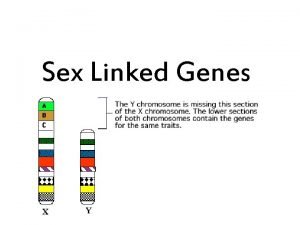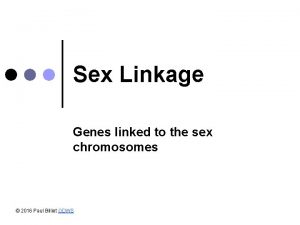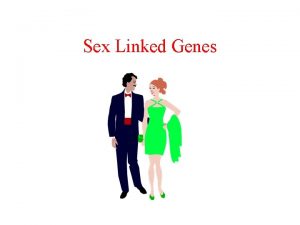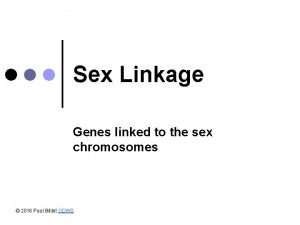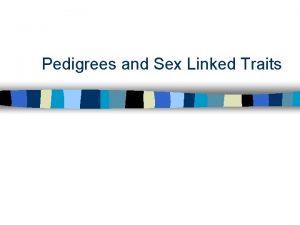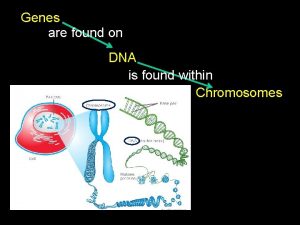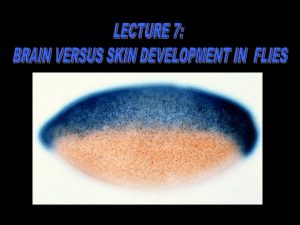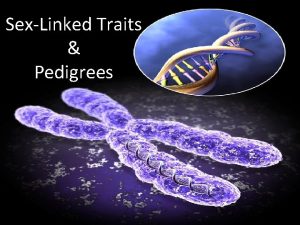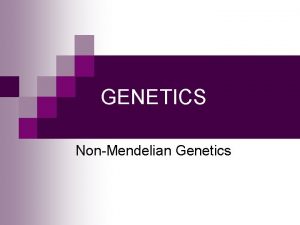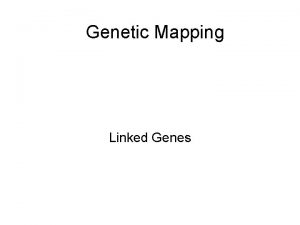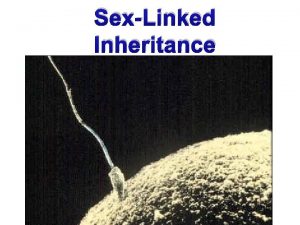Sex Linked Genes Sex Linked Genes Found on

















- Slides: 17

Sex Linked Genes

Sex Linked Genes • Found on 23 rd chromosome. • If a gene is found only on the X chromosome and not the Y chromosome, it is said to be a sex-linked trait. • Sex linkage is linked to the gender of the individual.

X Chromosome

Y Chromosome

XR XR XR

How we sex linked genes • Look at XX or XY chromosomes – Place superscript letter above X chromosome. • Female Homozygous (Dominant) – XH XH • Female Heterozygous (Carrier) – XH Xh • Female Homozygous (Recessive) – Xh. Xh • Male Dominant – XH Y • Male Recessive – Xh. Y


Give it a try… Parent Father (Carrier) Gametes Children Mother (Heterozygous Normal)

Recessive vs. Dominant • X-linked recessive disorders: – Common red-green color-blindness. – Hemophilia. – Duchenne muscular dystrophy. • More males than females display the disease. • X-linked dominant are very rare in humans (ie. hypophosphatemia) and affected males pass the condition only to their daughters who may pass this on to both sons and daughters.

• • • Examples of Sex-linked Traits: Red-green colorblindness Male Pattern Baldness Hemophilia Duchenne Muscular Dystrophy Hairy Ears – Y Chromosome

Hemophilia • Hemophilia is an X-linked recessive disorder – Inability to properly form blood clots. • Until recently, hemophilia was untreatable, and only a few hemophiliacs survived to reproductive age because any small cut or internal hemorrhaging after even a minor bruise were fatal. • Hemophilia is treated with blood transfusions and Factor 7.

Hemophilia continued… • Hemophilia affects – males much more frequently (1 in 10, 000). – females (1 in 100, 000). • Since males only carry one X chromosome, if that is defective, hemophilia will immediately show up. • Females, carry two X chromosomes. – If only one is defective, the other normal X chromosome can compensate. The woman will have normal blood clotting; she will simply be a carrier of the recessive defective gene.

Sample Sex-linked Trait Problem • In humans, red-green colorblindness is a recessive sex-linked trait. • It is found on the X chromosome, not the Y. • Because, males only have one X chromosome, they have a much greater chance of having red-green colorblindness. – Females would have to be homozygous recessive in order to have red-green colorblindness.


Color Blindness Parent’s Phenotypes: • Normal Vision Father x Normal Vision Mother (Carrier) Phenotypes of Offspring: Females Normal Vision Males w/ Colorblindness

Color Blindness Parent’s Phenotypes: • Normal Vision Father x Colorblind Mother Phenotypes of Offspring: Females Normal Vision Males w/ Colorblindness

First, let’s take a look at Queen Victoria’s son Leopold’s family. His daughter, Alice of Athlone, had one hemophilic son (Rupert) and two other children—a boy and a girl—whose status is unknown. a) What is the probability that her other son was hemophilic? b) What is the probability that her daughter was a carrier? Hemophilic? c) What is the probability that both children were normal?
 Linked genes and unlinked genes
Linked genes and unlinked genes Linked genes and unlinked genes
Linked genes and unlinked genes Linked genes
Linked genes Sex sex sex
Sex sex sex Kurt bumby
Kurt bumby Sex sex sex
Sex sex sex Snv sex
Snv sex Sex sex sex
Sex sex sex Glomerulus
Glomerulus Punnett square for blood type
Punnett square for blood type Linked genes
Linked genes Linked vs unlinked genes
Linked vs unlinked genes Genes located on the sex chromosomes
Genes located on the sex chromosomes Singly linked list vs doubly linked list
Singly linked list vs doubly linked list List adalah
List adalah Difference between an array and a linked list
Difference between an array and a linked list Sex linked pedigree
Sex linked pedigree Autosomal vs sex linked
Autosomal vs sex linked


